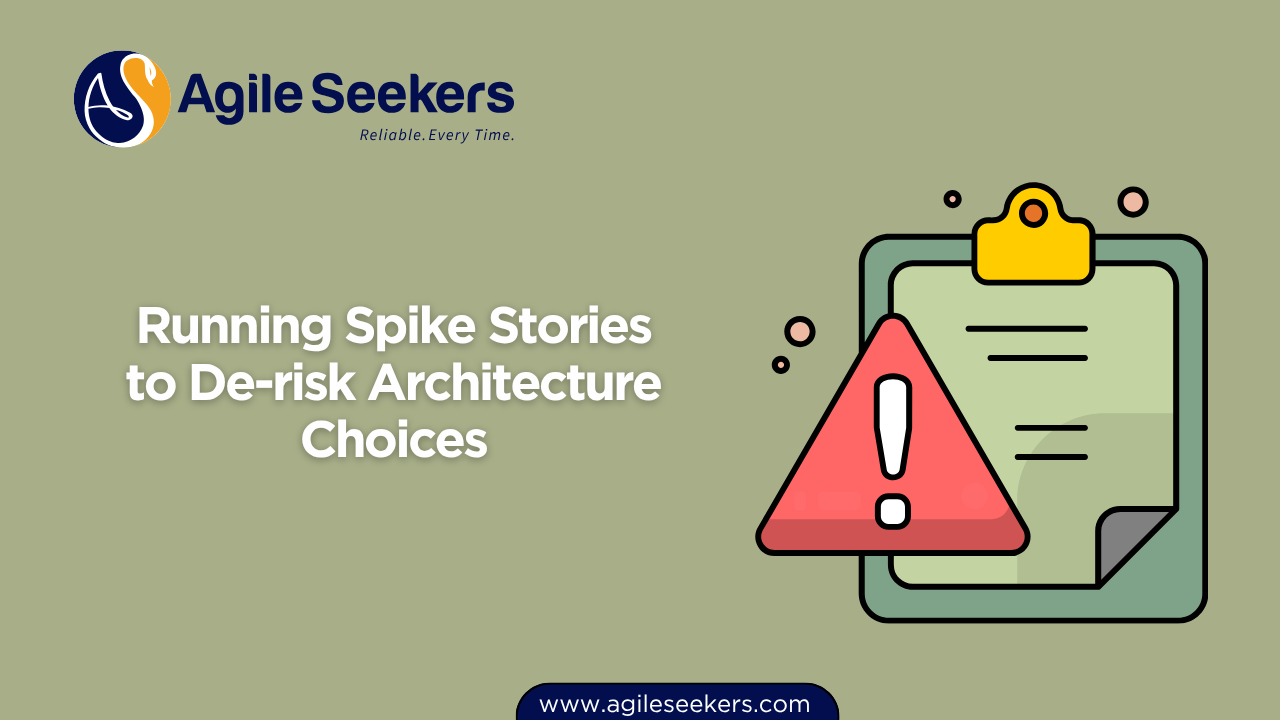Running Spike Stories to De-risk Architecture Choices

Running Spike Stories to De-risk Architecture Choices
When working on large-scale product development, architectural decisions carry long-term implications. Teams often face uncertainty around technology feasibility, integration patterns, data flows, or performance bottlenecks. Rather than committing to risky assumptions upfront, agile teams use a specific tactic: the Spike story.
A Spike is a time-boxed research activity used to explore solutions, reduce technical unknowns, and evaluate architectural options. It allows teams to learn fast without the pressure of delivering production-ready code. Running Spike stories helps de-risk architecture choices and ensures more informed decisions during upcoming sprints.
What is a Spike Story?
A Spike story is a backlog item that focuses on investigation rather than implementation. It helps answer critical questions such as:
-
Can this third-party API handle our expected load?
-
What’s the cost of switching from SQL to a NoSQL database?
-
How do we securely integrate our authentication system with a new identity provider?
Unlike regular user stories that deliver customer value directly, Spikes generate knowledge that guides future work. They might result in architecture diagrams, proof-of-concept code, benchmarking results, or documentation.
Spike stories are commonly used in frameworks like Scrum and SAFe. In the SAFe POPM Certification, Spikes are recognized as a key tool for addressing uncertainty and enabling flow-based planning in PI objectives.
When Should You Run a Spike?
Use Spikes when the team encounters high uncertainty in:
-
New technology exploration
-
System integration points
-
Performance or scalability expectations
-
Compliance or regulatory impacts
-
Deployment strategies (cloud-native, containerization, etc.)
You don't need Spikes for every unknown—just those that carry high risk or could cause rework later.
Writing Effective Spike Stories
A well-written Spike should be:
-
Time-boxed: Define a clear duration (e.g., 2–3 days)
-
Outcome-oriented: State what the team aims to learn
-
Bounded: Avoid scope creep—explore one unknown at a time
-
Testable: Define success criteria (e.g., "Able to deploy proof-of-concept with sample data")
Example Spike Story:
As a product team, we want to validate if we can use AWS Lambda with our current Node.js framework, so that we can decide if serverless architecture fits our needs.
Acceptance Criteria:
Can deploy a sample function using existing auth module
Function executes within 200ms latency
Logs and metrics accessible via CloudWatch
Integrating Spikes into Scrum and SAFe
Spike stories are estimated and prioritized like any other backlog item. In Scrum, they’re planned into sprints. In SAFe, they can appear in the Team or Program Backlog.
Key points to consider:
-
Track separately: Tag them distinctly so their output is clearly understood as research.
-
Discuss in refinement: Validate their need and define expected outputs.
-
Demo outcomes: Share learnings in sprint reviews, even if it’s just findings or diagrams.
When running SAFe teams, Product Owners and Product Managers often use Spike outcomes to update Capability or Feature acceptance criteria. This ensures architectural clarity and avoids surprises during implementation.
This is a key learning in the SAFe Product Owner Certification, where Spikes are treated as enablers of flow and predictability in Program Increment (PI) planning.
Benefits of Using Spike Stories
-
De-risk decisions: Avoid committing to flawed architecture paths
-
Encourage experimentation: Give teams room to test and learn
-
Improve estimates: Reduce guesswork in backlog sizing
-
Enhance collaboration: Drive early technical discussions between developers, architects, and product managers
-
Document learnings: Create artifacts for future team reference
Common Pitfalls to Avoid
-
Overusing Spikes: Don’t turn every technical task into a Spike
-
Vague objectives: Without clear questions, Spikes won’t yield actionable results
-
Skipping validation: Spike outcomes should lead to real decisions, not just documentation
-
No time-boxing: Open-ended research can derail sprint plans
Using Spikes in Regulated or Complex Projects
In regulated industries like healthcare or finance, architectural decisions have compliance implications. Running a Spike to explore regulatory requirements or test audit logging scenarios early can prevent costly rework.
Similarly, large system migrations—such as moving to event-driven architectures—should be preceded by multiple targeted Spikes to evaluate:
-
Message schema design
-
Broker performance
-
Backward compatibility
This aligns with project risk management practices taught in PMP certification training, where proactive discovery helps mitigate scope, schedule, and cost risks.
Tracking and Sharing Spike Outcomes
Spikes should generate outcomes that influence backlog items:
-
Documentation: Record findings in Confluence or an internal wiki
-
Code samples: Store PoCs in a feature branch or sandbox repo
-
Recommendations: Summarize trade-offs and decisions for the team
It’s valuable to demo the results, even if they aren’t customer-facing. This helps business stakeholders understand the value of technical exploration.
Final Thoughts
Running Spike stories isn’t about slowing down delivery. It’s about creating space to make smarter choices, avoid technical debt, and empower cross-functional teams with validated knowledge.
For product managers, especially those pursuing SAFe POPM training, Spikes offer a structured way to balance exploration with execution. For project managers preparing for the Project Management Professional certification, they represent a proactive risk mitigation technique.
Used wisely, Spike stories can turn uncertainty into strategy—and strategy into sustainable delivery.
Also read - Planning and Executing Technical Discovery Sprints
Also see - Handling Rollback Strategies for Failed Product Deployments




















